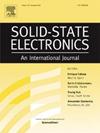Analysis of operation delay and switching speed limitation due to source/drain resistance and subgap density of states in amorphous InGaZnOx/HfZrOx ferroelectric thin-film transistor
IF 1.4
4区 物理与天体物理
Q3 ENGINEERING, ELECTRICAL & ELECTRONIC
引用次数: 0
Abstract
In recent years, ferroelectric memory has garnered significant attention as a next-generation non-volatile memory capable of operating at a low voltage and high speed, making it suitable for embedded memory and in-memory computing applications. Previous research has extensively focused on optimizing the polarization switching speed and operational characteristics of ferroelectric thin films themselves. Recent studies have also demonstrated experimental implementations of memory devices utilizing various semiconductors beyond silicon channels. However, to effectively apply and evaluate ferroelectrics at the transistor level for memory applications, it is crucial to consider not only the intrinsic properties of ferroelectric materials but also to integrate and analyze the performance characteristics of transistors. The size of ferroelectric field effect transistors (FeFET) and the characteristics of semiconductor channel material can significantly influence memory performance and operational speed. Differences in performance may arise depending on the semiconductor channel employed and how defects respond within the materials other than ferroelectric film.
In this study, ferroelectric thin-film transistors (FeTFTs) and corresponding test element group (TEG) with an amorphous InGaZnOx (a-IGZO) channel and HfZrOx (HZO) ferroelectric insulator were fabricated and analyzed to investigate the correlation between operational speed and semiconductor channel properties. Measurements, including DC transfer curves, gate capacitance versus gate voltage (CGDS–VG) curves, and the frequency dispersion of CGDS, were conducted. The results confirmed potential limitations in operational speed due to a-IGZO channel characteristics. TCAD simulations were calibrated considering the extracted subgap density of states (DOS) and contact serial resistance, revealing that the speed of FeTFTs can be constrained by serial resistance and defect responses. These findings underscore the necessity of selecting appropriate device structures and materials for effectively evaluating FeTFTs, and highlight the complexities involved in assessing ferroelectric memory performance, emphasizing the interplay between ferroelectric films and semiconductor channels, interface charges, defect levels influenced by processes, and inherent semiconductor channel performance. This research provides insights into the comprehensive analysis required for evaluating ferroelectric memory devices effectively.
非晶InGaZnOx/HfZrOx铁电薄膜晶体管源漏电阻和状态子隙密度导致的运行延迟和开关速度限制分析
近年来,铁电存储器作为能够在低电压和高速下工作的下一代非易失性存储器引起了人们的广泛关注,使其适合嵌入式存储器和内存计算应用。以往的研究主要集中在优化铁电薄膜本身的极化开关速度和工作特性上。最近的研究还展示了利用硅通道以外的各种半导体的存储器器件的实验实现。然而,为了在晶体管层面有效地应用和评估铁电体用于存储应用,不仅要考虑铁电材料的固有特性,而且要集成和分析晶体管的性能特征。铁电场效应晶体管(FeFET)的尺寸和半导体沟道材料的特性对存储器性能和运算速度有显著影响。性能的差异可能取决于所采用的半导体通道以及在铁电薄膜以外的材料中缺陷的响应方式。在本研究中,制备了具有非晶InGaZnOx (a-IGZO)沟道和HfZrOx (HZO)铁电绝缘体的铁电薄膜晶体管(fefts)和相应的测试元件组(TEG),并对其进行了分析,以研究运行速度与半导体沟道性能之间的相关性。测量了直流转移曲线、栅极电容-栅极电压(CGDS - vg)曲线和CGDS的频散。结果证实了a-IGZO通道特性对操作速度的潜在限制。考虑提取的子隙态密度(DOS)和接触串联电阻,对TCAD模拟进行了校准,结果表明,串联电阻和缺陷响应会限制fet的速度。这些发现强调了选择合适的器件结构和材料来有效评估场效应晶体管的必要性,并强调了评估铁电存储器性能所涉及的复杂性,强调了铁电薄膜和半导体通道、界面电荷、受工艺影响的缺陷水平和固有半导体通道性能之间的相互作用。该研究为有效评估铁电存储器件所需的综合分析提供了见解。
本文章由计算机程序翻译,如有差异,请以英文原文为准。
求助全文
约1分钟内获得全文
求助全文
来源期刊

Solid-state Electronics
物理-工程:电子与电气
CiteScore
3.00
自引率
5.90%
发文量
212
审稿时长
3 months
期刊介绍:
It is the aim of this journal to bring together in one publication outstanding papers reporting new and original work in the following areas: (1) applications of solid-state physics and technology to electronics and optoelectronics, including theory and device design; (2) optical, electrical, morphological characterization techniques and parameter extraction of devices; (3) fabrication of semiconductor devices, and also device-related materials growth, measurement and evaluation; (4) the physics and modeling of submicron and nanoscale microelectronic and optoelectronic devices, including processing, measurement, and performance evaluation; (5) applications of numerical methods to the modeling and simulation of solid-state devices and processes; and (6) nanoscale electronic and optoelectronic devices, photovoltaics, sensors, and MEMS based on semiconductor and alternative electronic materials; (7) synthesis and electrooptical properties of materials for novel devices.
 求助内容:
求助内容: 应助结果提醒方式:
应助结果提醒方式:


